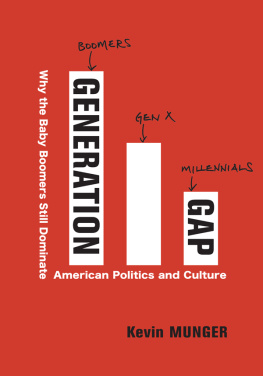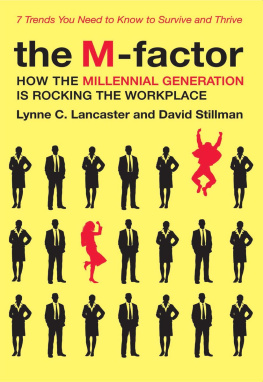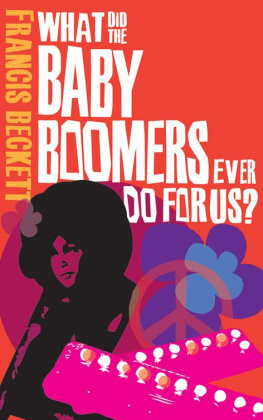
Generation Jan: The Xers as Middle Children
By Matthew C. Henry
Copyright 2012 by Matthew C. Henry
Cover Copyright 2012 by Dara England and Untreed Reads Publishing
The author is hereby established as the sole holder of the copyright. Either the publisher (Untreed Reads) or author may enforce copyrights to the fullest extent.
This ebook is licensed for your personal enjoyment only. This ebook may not be resold, reproduced or transmitted by any means in any form or given away to other people without specific permission from the author and/or publisher. If you would like to share this book with another person, please purchase an additional copy for each person you share it with. If youre reading this book and did not purchase it, or it was not purchased for your use only, then please return to your ebook retailer and purchase your own copy. Thank you for respecting the hard work of this author.
While the author has made every effort to provide accurate telephone numbers and Internet addresses at the time of publication, neither the publisher nor the author assumes any responsibility for errors, or for changes that occur after publication. Further, the Publisher does not have any control over and does not assume any responsibility for author or third-party websites or their content.
Other Titles in the Untreed Reads Essay Series
The Gob by Liz Dolan
http://www.untreedreads.com
Generation Jan: The Xers as Middle Children
By Matt Henry
Introduction: Marcia, Marcia, Marcia!
Every generation has their collective texts, that collection of pop culture media that binds the generational cohort together, and ultimately brands them. The Baby Boomers had Elvis, The Mickey Mouse Club, and James Dean. Generation X had new wave music, the films of John Hughes, and The Transformers . Generation Y (or the Millennials as many prefer, because theyre just too special to be compared to anyone else) has hip hop, Pokemon, and Dude, Wheres My Car? As much as these artifacts are influenced by focus group research on their respective audiences, they also create and perpetuate influences on their respective audiences. Its that awkward conundrum of the chicken and egg that pop culture scholars spend their careers trying to pinpoint. Did the American family of the baby boom create the Cleavers, or did the Cleavers create the portrait of the American family, as television audiences tried to emulate what they saw? Did John Hughes know kids like Farmer Ted and Samantha Baker, and thus base the characters on real people, or did his media interpretation of upper middle class midwestern adolescents instead create a generation of teenagers who took their identity cues from his filmsmuch as Madonna single-handedly saved the lace-glove and plastic bangle bracelet industry in 1984 by spawning a horde of wannabes.
Of the pantheon of Gen X pop culture media, few artifacts are as pervasive as The Brady Bunch. Movies were often limited in scope of influence because of monetary access for tickets, and video games had a merciless appetite for quarters. While music was more pervasive, the top-40 format ensured the eventual antiquation of popular songs, to make room for new ones, making recorded media the only real way to have constant access to a shared song. Recorded media, again, required money to possess and play. But broadcast television was free, and by the 1970s most families not only had one television, but several families had at least one television for the kids as wella convenient way for the Boomers to pacify and occupy their brood when the presence of children just became too heavy or otherwise inconvenient. Whether by intention or fate, The Brady Bunch became a staple of the Gen X television diet.
Early Xers saw the show in first run on the networks. Middle and later Gen Xers would find that the show was often their afterschool babysitter, watching it (first in syndication and later in basic cable) as latchkey kids. As the Boomers transitioned from children and adolescents into parents, it was clear that most hadnt abandoned the spoiled and entitled nature of their youths.
You broke or otherwise lost interest in your Barbie/G. I. Joe? Its okay, heres a new one! became Your husband/wife is a drag? Its okay, go find one that isnt!
By the time I was 21 (1993), my mother had had three husbands, and my father had had four wives and two broken engagements. Between those marriages, I boasted eight step-siblings, in addition to the brother and two sisters nature provided me with. So what better way to prepare a generation of children whose parents might have two or three marriages eachfueled by their me first mindsetthan a show about a single father and single mother who marry and combine their respective families in an environment where dad can maintain a comfortable standard of living with his job, mom can stay home, a live-in maid can manage domestic duties like laundry, cleaning, and having afterschool pie on demand, and problems are introduced and solved in twenty-two minutes? It was like television execs had a glimpse into the future and used the show as proactive social engineering to prepare a generation of latchkey Xers for the merged families that awaited many of them.
The Brady Bunch also grappled with the adolescent archetypes of the time, with Greg and Marcia as the prototypical high school kidsall-American, beautiful, popular, smart, and athletic. Bobby and Cindy were the prototypical elementary-aged childrencurious, innocent, and often precocious. And in the middle, Peter and Jan demonstrated the struggles and transitions of the onset of adolescence in junior highthats Middle School to any Millennials reading this. Peter experienced the awkward transitions of puberty in one memorable episode. Find any Gen Xer and begin the refrain to Time to Change, and wait for a clumsy imitation of Peters cracking voice in the chorus. Jan dealt with the social and cosmetic transitions of adolescence, like finding a boyfriend (or inventing one if a real one is unavailable) and wearing glasses. Yet Jan also fills the shoes of another archetype: the middle child. She frequently finds herself in various states of social neglect from both her parents and siblings, simply because they spend so much time focusing on the needs of the first and last born, that those in the middle fall through the cracks.
As other cultural critics and the media at large ponder this sense of generational warfare in America, I would suggest that we, Generation X, are Jan Bradythe archetypical middle child in the modern American generational structure.
Throughout the series, Jan found herself eclipsed in two shadows. On one side, she had Marcias beauty and popularity (and consequent social currency) overshadowing hers, and on the other side, she had Cindys curled-pigtail cuteness consuming whatever attention scraps and social currency Marcia may have left behind. It seemed that Jans sole modus operandi in the series was finding ways to somehow stand out and differentiate herself from her biological and adoptive broodwhether donning a cheap black wig and christening herself the new Jan Brady for a dance, or engineering a poorly thought out plan to buy their parents an engraved silver platter for their anniversary. Regardless of the efforts, Jan always failed. Her attempt at self-reinvention only earned her a patronizing talk from her stepfather about self-esteem, and her siblings had to come to her rescue in order to realize her platter dreams.
And now, as Gen X steps into generational adulthood, we find ourselves in the same positionsandwiched between two cohorts that seem determined to consume any influence, wealth, and social currency they can procure, not even considering the generation that will be funding ones retirement while training the other to take the reins of leadership in twenty years.
Next page










